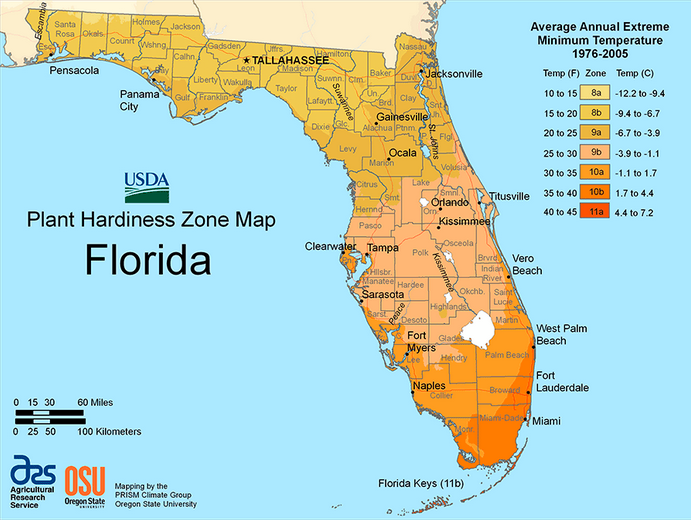Spanning from the Keys’ sandy beaches to the mossy panhandle, Florida provides a unique environment for a variety of fruit trees to flourish. Planting fruit trees can be a rewarding personal or community effort. Not only do fruit trees provide a delicious and nutrient dense crop, but growing them locally fosters a deeper appreciation for the natural world. Fruit trees also benefit local environments in numerous ways, but before diving into that, let’s take a look at the fruit trees that thrive in each of Florida’s distinct regions.
Growing Zones
Growing zones in the state include temperate, tropical and subtropical areas. By using a hardiness map like the one below, it’s easy to determine what plants will thrive in local environments. Hardiness zone maps denote minimum average temperature by region–important information for anyone looking to plant fruiting trees.

Photo Credit: USDA
North Florida
Central Florida
South Florida
Native Florida Fruit Trees
The best planting option, both for the environment and for the wallet, are native trees. Many varieties of Florida natives are delicious and unique fruits that you won’t find at the local Publix.
- American Persimmon: North/Central Florida, fruits from August-November7
- Chickasaw Plum: North/Central Florida, grows quickly, fruits from May to June8
- Sea Grapes: South Florida/Coastal, ready for harvest in August9
- Passionfruit: North/Central/South Florida10
Give Fruit a Chance!
Growing fruit trees at home is a great way to connect with the environment and harness community. The benefits of planting fruit trees range from reduced energy costs to personal reward.
- Foster local wildlife: fruit trees provide sanctuary and food to an array of animals and insects. In Florida, birds like Cedar Waxwings and Gray Catbirds rely on native fruit trees for nutrients and shelter11. Additionally, flowering fruit trees provide pollen for bees who face growing threats across the country.
- Free produce: fruiting trees are an investment that pay for themselves. Mature avocado trees can put out more than 200 avocados a year during their season12, providing ample food and endless opportunities for (free!) guacamole. With such a harvest, it’s easy to share with neighbors–both human and wildlife.
- Less chemicals: growing fruit trees at home gives the grower more agency and oversight, often allowing for pesticides to be cut out altogether. In turn, organic produce becomes not just accessible, but also cheap.
- Lower energy costs: One often overlooked benefit of planting fruit trees is the shade they offer. Growing trees around the house, neighborhood or school can significantly lower utility costs–especially in a hot, sunny state like Florida13. Thus, the shade they provide saves energy.
- CO2 sequestration: Trees capture carbon through photosynthesis, binding it with sugar which they use to make the wood that constitutes their branches, trunks and roots14. Thus forests are a natural carbon sink. In recent years, orchards have been studied for their carbon sequestration capabilities. A 2016 study highlighted how such systems store carbon over time, proving that fruit trees are equally sustainable as they are productive15.
Give the Gift of a Florida Fruit Tree!
This holiday season, IDEAS For Us is hosting a giving drive centered around fruit trees, which as we learned, nourish communities and ecosystems alike. Give the gift of a fruit tree this holiday season! Invest in communities in need by purchasing a fruit tree for $50. A single tree provides food, shade, and habitat, and heals the ecosystem for years to come. A fruit tree is truly the gift that keeps on giving. Donate one tree, several, or even a whole orchard…every tree counts!
Sources
- https://fruitinformation.com/fruit-trees/best-fruit-trees-to-grow-in-florida/
- https://fruitinformation.com/fruit-trees/best-fruit-trees-to-grow-in-florida/
- https://www.flgardening.com/best-fruit-trees-to-grow-in-florida/
- https://cisr.ucr.edu/invasive-species/huanglongbing-hlb-or-citrus-greening
- https://www.flgardening.com/best-fruit-trees-to-grow-in-florida/
- https://www.flgardening.com/best-fruit-trees-to-grow-in-florida/
- https://offbeet-gardener.com/2022/03/florida-native-fruit.html
- https://offbeet-gardener.com/2022/03/florida-native-fruit.html
- https://offbeet-gardener.com/2022/03/florida-native-fruit.html
- https://offbeet-gardener.com/2022/03/florida-native-fruit.html
- https://www.nsis.org/bird/bird-f-fruit.html
- http://ucavo.ucr.edu/general/answers.html
- https://homeguides.sfgate.com/fruit-trees-environment-59135.html
- https://extension.psu.edu/how-forests-store-carbon
- https://arpi.unipi.it/retrieve/handle/11568/801302/116272/Scandellarietal2016.pdf








